When I added the addendum photos I lost the entire original message. So I've
re-posted it here...........................................
This map of the Missouri Botanical Garden in Saint Louis clearly shows the various types and styles of gardens within the overall garden. Seiwa-en is the area enclosed by the rather ragged red line I added. As you can see Seiwa-en is a substantial part of the garden as a whole. Since the map shows walkways you can see there are several locations that offer entry to Seiwa-en.
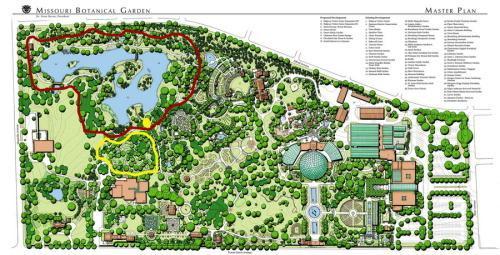
The area encircled in yellow has always been my favorite entry point because it offers such an interesting study in contrasts. The yellow line encircles the woodland garden and it fascinated me to take about 10 steps and move from a garden filled with trillium, ferns, hellebores, skunk cabbage and blue-eyed Mary groundcover to a position that overlooked a good portion of the lake in Seiwa-en:
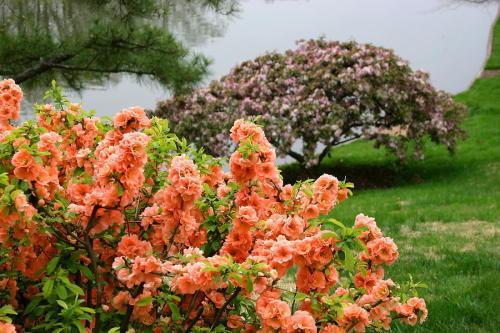
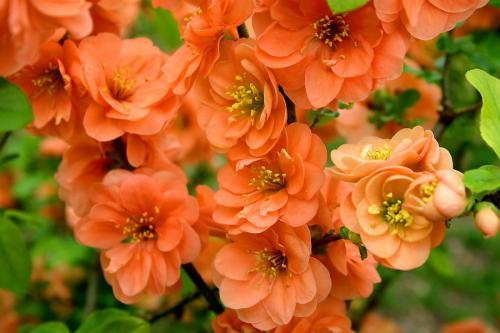
Of course, it didn't hurt that this spot [the yellow dot on the map] is occupied by a stunning specimen of a dwarf orange-flowering Japanese quince [Chaenomeles japonica var. alpina]. From that spot I usually took the walkway that moved around the lake in a clockwise direction.
Moving in that direction will take the visitor past beautiful lawns that slope down to the water's edge… lawns containing carefully pruned and shaped pines and flowering cherries:
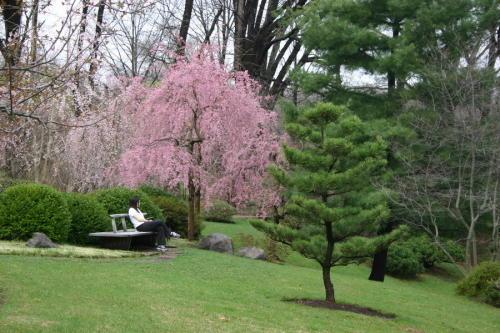


Within these lawn areas are spaces containing carefully raked gravel beds that display somewhat concentrated plantings of Japanese maples, azaleas and pines:
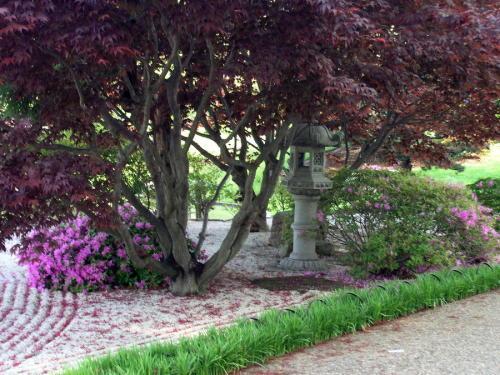
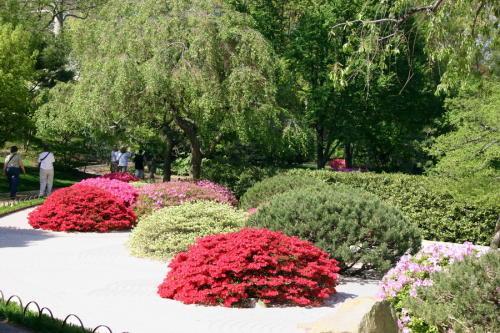
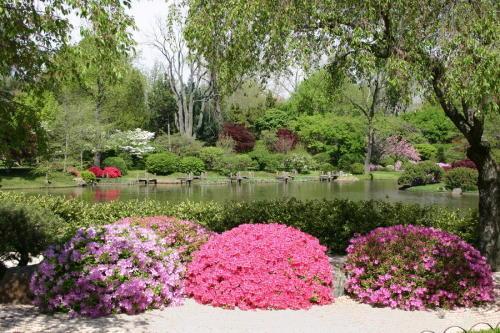

Further along a six foot deep, one hundred foot long flower bed makes a very dramatic statement… the entire bed is planted to overflowing with herbaceous peonies:
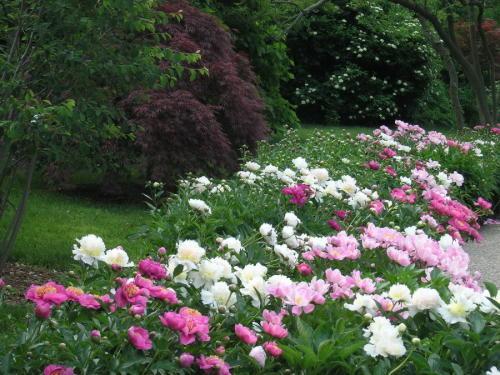
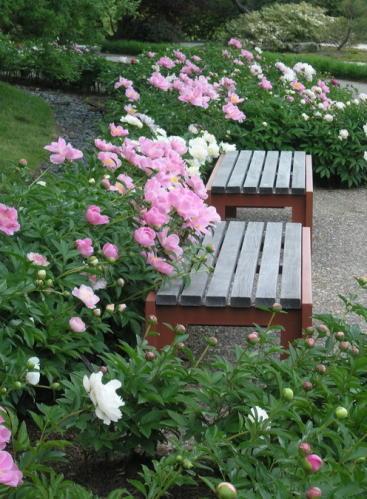
Two benches allow visitors to sit, quite literally, right in the middle of this peony bed. And since some of these peonies are fragrant this experience is a heady one. Unlike the spaces described above the peony border is not on the "lake side" of the walkway. This allowed the designer to use Japanese maples, paperbark maples and viburnnums as a backdrop for the peonies. The first photo of the peony border lets you see a few of these plants and their relationship to the peonies.
Not too far beyond the peony border you will cross a bridge. The bridge is attractive, but it is not the highpoint of this particular area. This area has lawn that is only a few inches above the surface of the lake. This is where a lot of parents allow their small children to offer food pellets to the altogether impressive population of VERY large koi. I found this area photographs best when you are standing across the lake from the bridge:
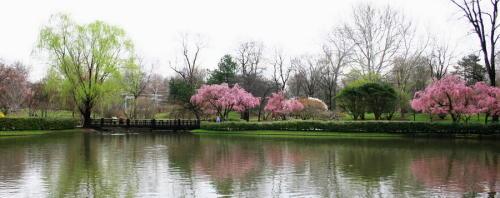
This position allows you to see the plantings surrounding the bridge… plantings that are especially beautiful in March and early April. Cherry trees are in bloom and a stately and well-shaped weeping willow has low branches that sweep across the lake's surface. It is a beautiful and peaceful scene.
This scenic photo of the bridge and shoreline was taken while standing on another bridge. This type of bridge, a Japanese zigzag bridge [yatsuhashi], has acquired a degree of fame outside Japan. The myth surrounding this type of bridge suggests it has value because it deters evil spirits… spirits that can only travel in straight lines.
This myth is utterly false… in short, it's a myth. The bridge zigzags inorder to slow the pace of those crossing it… encouraging them to pause and enjoy those garden elements in the immediate vicinity.
This particular zigzag bridge weaves in and out among large wood-framed planters set along the shoreline of the lake. These planters contain dense stands of a particularly beautiful Japanese iris [Iris ensata] called 'Prairie Glory':



Beyond this point the walkway winds past several specimen plants carefully positioned in the lawn areas. One specimen worth seeing is a nicely pruned dwarf crabapple [Malus spp.]:

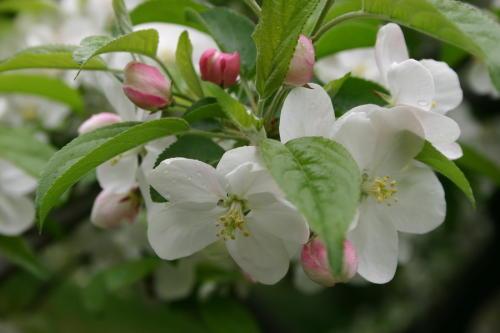
A little further on there is another bridge. This one is a wooden arched bridge [sori bashi] and it leads from the edge of the lake to an island that contains a Japanese tea house:
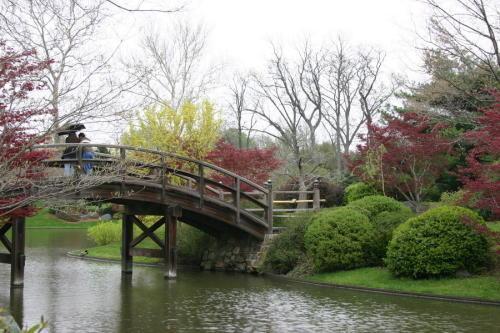
There is more to Seiwa-en beyond this bridge… a beautifully carved fusen basin, a waterfall, a delightful rock lined stream that feeds the lake………………. And I might add photos of these at a later date. I hope, however, that what you have seen so far will interest you in visiting this remarkable garden.
Background: Seiwa-en, at 14 acres one of the largest Japanese gardens in North America, opened to the public in 1977. It was designed by Koichi Kawana, a remarkably talented and knowledgeable gentleman who, for 24 years, taught Japanese art, environmental design, and Japanese landscape architecture at UCLA. Beyond that he also designed Japanese gardens for the Chicago Botanic Garden, the Denver Botanic Garden, the Minnesota Landscape Arboretum, the Bloedel Reserve and the Memphis Botanic Garden… as well as the Pavilion of Japanese Art bonsai collection at the Los Angeles County Museum of Art.
Professor Kawana designed Seiwa-en as a "wet strolling garden" [Chisen Kaiyushiki]… a style of garden that was immensely popular with Japanese feudal lords [daimyo] during the Edo Period in 19th century Japan. These gardens were noted for having a lake as the main feature… surrounded by extensive lawn areas that created a feeling of openness unique to this garden style.
I hope this information isn't boring to you. Like many of you a garden for me is ALL about the plants. But gardens are also all about the people who designed, created and nurtured them. I wanted you to know about Professor Kawana because he was an awesome talent worthy of respect.


















